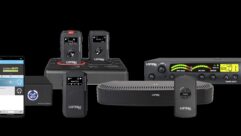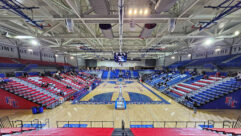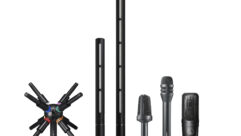
Norristown High School Gets New Audio System by Loud Technologies
Oct 3, 2006 11:12 AM

System designer Kyle Rosenbloom sits at the new Mackie TT24 digital console installed at Norristown High School.
Implementing modern AV production technology within the confines of an existing facility can prove to be a tall order for systems integrators. Challenges abound, particularly if the venue was built before the “modern era” of professional systems.
Planet Medley, the install division of Bryn Mawr, Pa.-based Medley Music, recently faced this situation when charged with implementing a new full-range sound reinforcement system to serve the 1,200-seat auditorium at Norristown High School.
Built in 1973, it’s still a highly functional, beneficial space for a range of purposes that include theatrical productions, concerts, classes, and meetings, but hard surfaces abound while the existing infrastructure for cabling is insufficient and largely inaccessible. The room offers a very wide main floor with seating for about 900, topped by a balcony with seating for another 300. Adding to the acoustical challenge is a huge steel door that can be rolled out to close off the balcony to create additional classroom space, thereby creating a massive “slap-back generator.”
“You can clap your hands on stage and still hear it reverberate more than two seconds later, but taming the space with sufficient acoustical treatment is cost-prohibitive. Meanwhile, trying to run analog cabling would require a major construction project,” explains Kyle Rosenbloom, who heads up Planet Medley. “Both the acoustical and infrastructure difficulties led us to an all-digital solution.”
With acoustical treatment out of the picture, Rosenbloom began looking for ways of tightly controlling the output and coverage of the new system’s loudspeakers. The search included evaluation of EAW DSA series loudspeakers, developed expressly for situations where column loudspeakers would be utilized, but with output that can be digitally steered to tightly focus energy on the coverage area and off of nearby reflective surfaces.
Rosenbloom arranged to get a demonstration of DSA250 loudspeakers in the auditorium, which cinched his decision. “DSA performance is amazing,” he says. “The difference between what it can do in comparison to conventional loudspeakers is night and day, making it a life-saver for tough situations like this one.”
The mid-/low-frequency section of the DSA250 is comprised of a line of eight 4in. cone drivers that are slightly offset to help minimize enclosure height, while the high-frequency section includes eight soft-dome tweeters in a very shallow multi-cell horn. The vertical spacing of all drivers creates a higher resolution that optimizes the onboard DSP control.
Rosenbloom’s design includes two sets of DSA250 loudspeakers mounted to each side of the very wide stage proscenium. The lower set teams up to provide coverage to the entire main floor, while the upper set handles balcony coverage needs. For situations where the balcony door is closed, the upper set of loudspeakers is turned off via a subgroup preset on the system’s new Mackie TT24 digital console. Enhanced bass energy is supplied by two EAW NTS22 dual-12in.-loaded subwoofers positioned in cavities beneath the stage.
The DSA loudspeakers are mounted with Omnimount 120.0 series brackets that are attached “backward” to put the ball portion of the mount on the back of the loudspeaker, resulting in more horizontal angling capability. Combined with the 120-degree horizontal output of each DSA250, the entire room is easily covered with stereo output.
“Once we had the loudspeakers in place, we then only needed to use the DSA Pilot for optimization,” Rosenbloom adds. “Basically, you just enter the dimensions of the coverage area, the incline of the room, and so forth, and the program configures the system precisely from there. The minimal amount of cabling this approach requires is another benefit. There’s just one XLR cable to each loudspeaker, and these run just a short distance from the onstage rack.”
The system mix/control position at the rear of the balcony was retained due to more infrastructure cabling issues. This proved a primary factor in the selection of the TT24 digital console, because it dramatically simplifies setting the system for optimum operation and configuration via one-button access to presets. Another nifty solution provides remote mixing capabilities, with a wireless network allowing users logged on to a PC on the main floor to access and control key TT24 mixing parameters.
The TT24 and DSA loudspeakers are linked via another digital component, an RSS 32 by 8 digital snake system requiring just one Cat-5 cable from the control position to the control/input box positioned at one of the stage wings. “It’s simple and slick,” Rosenbloom concludes. “Everything patches in at the stage, the mic preamps can be remotely controlled, and it’s compact and stable.”









